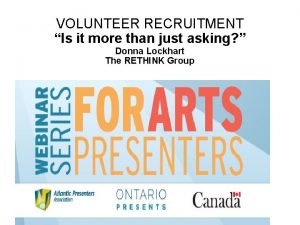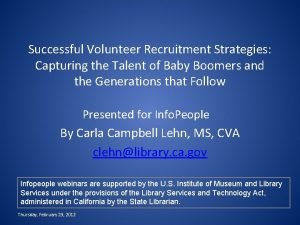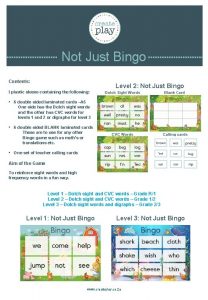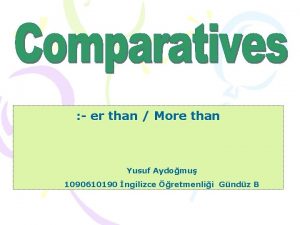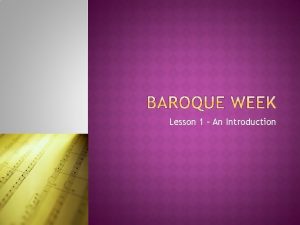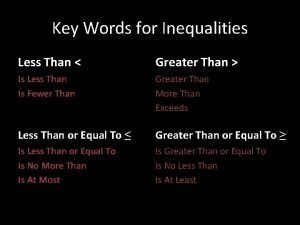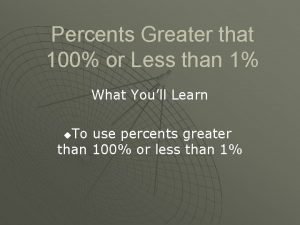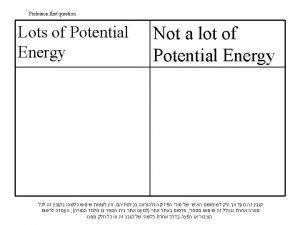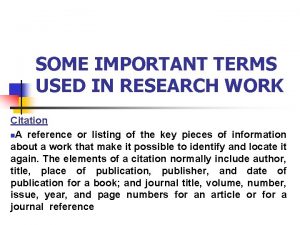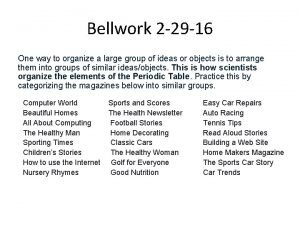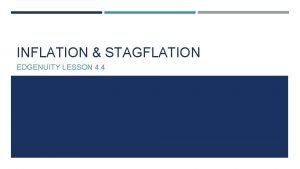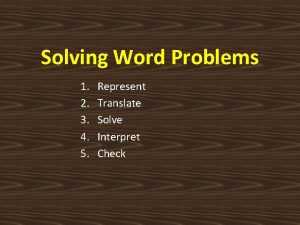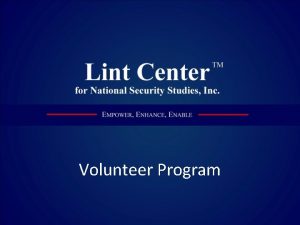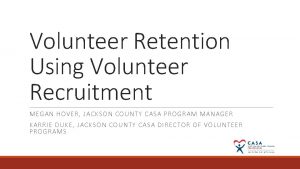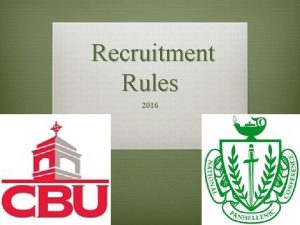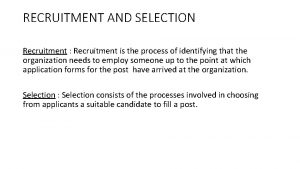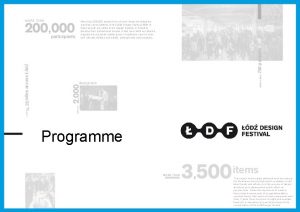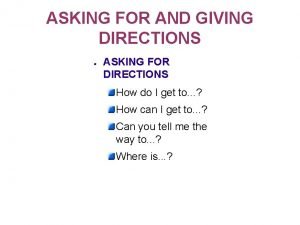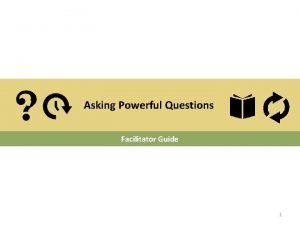VOLUNTEER RECRUITMENT Is it more than just asking









































- Slides: 41

VOLUNTEER RECRUITMENT “Is it more than just asking? ” Donna Lockhart The RETHINK Group

Reminders • You can hear us, we cannot hear you! Can’t hear? • Try turning up your volume • Call in by phone or use your computer headphones Have a question? Use the Q&A box, any time. Will have time at the end after the webinar. Downloads • • • Webinar recording PPT Slide presentation Template for Volunteer Position/Opportunity Description Recruitment Plan Volunteer Alberta: Recruitment Resource

WELCOME A “dynamic tension” exists between Recruitment and Retention and Recognition in volunteer management. What you do or don’t do in one area will impact on the other.

AGENDA 1. 2. 3. 4. 5. Summarize your survey questions and challenges RECRUITMENT – what does it really mean? What are the challenges today? How can you position yourself to be more successful? Role of Motivation and Position Descriptions 4 top recruitment methods

Survey Results: Good-Bad News 1. 50% of you have written position descriptions for volunteers 2. 38% of you have someone designated to recruit volunteers 3. You use a wide variety of methods to recruit. The most successful include: personal ask and volunteers asking others to volunteer

Most challenging roles to recruit for include: Leadership Roles – Board, President, Secretary, Person in charge, Treasurer, grant writer, events coordinator. “Traditional/Task Roles” such as facility repair and maintenance; ushers; coat check; site patrol overnight; bar and concession; sales at intermission; seller of merchandise; greeters; little tasks for printing/poster distribution.

2 Key Challenges “How do I get someone to stay long term? “How do you get people to commit and stand by what they say they will do? ” This illustrates shifts in: a)The term ‘long term’ b)Commitment and connection to motivation/interest c)Traditional roles for volunteers

RECRUITMENT Traditional Definition: “ Finding the right person for a volunteer position for work/tasks, that the organization needs to fill. “ Traditional Roles: Volunteer roles in organizations were based on getting the job done not on what the volunteer needed to be successful/happy/satisfied. Jobs like building/moving sets: taking and administering membership/registrations; phone calls; stuffing envelopes for mail outs …These jobs were happily done by Veteran Volunteers. (those volunteers who would do whatever you asked of them and then some!) A “task-focused approach” to volunteer engagement. Recruitment RE-Defined today: “Person-centered approach. ” Talking to potential volunteer, determining interests/skills and building a new role for them in the organization. Looking at the work to be done that is still critical and finding new ways to package and market it. Importance of creating a volunteer position together. Often calling this the ‘acquisition’ of volunteers.

The organization has needs and volunteers have needs. When you can meet both there is a win-win. Let’s do a quick poll to see just how many volunteers you are utilizing on a regular basis? This helps all of us understand the range of your volunteer requirements.

Challenges Today • Increased competition for volunteers • Increased demand • Decrease in numbers volunteering • Decrease in volunteering after age 55 and more drastically after 65 • Decrease in the amount of time volunteering and in length (episodic) • Different age groups responding differently to volunteering (impact of Youth and Baby Boomers) • Decrease in interest with traditional volunteer roles and leadership roles

An AHA Moment…. If you are having trouble recruiting volunteers, look first at the ‘work’ you are asking them to do.

Before recruiting think about… 1. You need clear, specific position descriptions – that are attractive and appealing. You may be building a new role for a volunteer or rethinking how you promote the tough ones to make them more appealing (sample template for you). 2. People don’t volunteer to “stuff envelopes”…they do volunteer to help achieve something…. keeping seniors independent; promoting the economics of arts/culture; making a meal a social time; protecting or improving the culture of a community; keeping healthy/active brains…. ”outcome based. ”

3. 4. 5. Since volunteers are not ‘paid, ’ their reason or motivation for helping is often tied to a cause they believe in. Motivation is important in recruitment. Offer opportunities that appeal to motivation, interest, passion, make them feel good, utilize skills and experience. Recruitment efforts are more successful when you put them into terms of what the program or service is trying to achieve.

Sample Position Description • Use this as a starting point • Make it clear and specific so volunteers know what is expected • List outcomes and impact • Make it creative and unique to your organization • Be honest and use the PD as a recruitment tool

MOTIVATION “Whatever stimulates people to act by offering them an opportunity to do what they like to do or are interested in doing. ” Motivation varies by AGE (National Survey of Giving, Volunteering and Participating 2000)

Top Motivations for Volunteering • To help a cause in which they personally believe (96%) • To use their skills and experience (78%) (Canadians between 15 -34 years said 83%) • Because they have been personally affected or know someone who has been affected by the cause the organization supports (67%)

• To explore their own strengths (54%) (68% between ages 15 -24) • To fulfill religious obligations or beliefs (29%)(50% of 55 years of age and over) • Because their friends volunteer (25%) • To improve their job opportunities (22%) (54% between ages 15 -24)

Tips 1. Understanding Motivation is a powerful tool in both Recruitment and Retention. Can you frame a volunteer opportunity to appeal to motivation? 2. The degree of the match (my motivation to volunteer) can influence recruitment (acceptance of role) and how long a person stays. 3. The degree of the match does effect the volunteer’s satisfaction in a positive direction. 4. Continued satisfaction and retention was found NOT to be a function of initial motivation! (implies motivation changes over time).

Remember the TOP FOUR MOTIVATORS? 1. TO HELP A CAUSE THEY PERSONALLY BELIEVE IN (96%) 2. TO USE THEIR SKILLS AND EXPERIENCE (78%) 3. HAVE BEEN PERSONALLY AFFECTED OR KNOW SOMEONE (67%) 4. TO EXPLORE THEIR OWN STRENGTHS (54%)

“Cause” they believe in…. • What can we do to connect volunteers to our cause…. ? • How might we write the position description to appeal to someone whose motivation might be to support the arts/culture/heritage? • Is there an ‘impact’ that you can demonstrate?

“Use skills and experience…. ” • What type of opportunities might appeal to people wanting to use skills and experience…. ? • Any specific age group this would appeal to? • How might we write the position description to illustrate skills needed or experience shared? • Are there new roles you might create that would appeal to someone who wants to use skills?

Summary • Understanding motivation helps us put the right volunteer into the right position. • Motivation changes over time…. what brought a volunteer…might not be what keeps them. • We need to build relationships with volunteers so we can scout in advance when and how to offer them something new…this will help with retention. • Having a clear, exciting position description is also a motivator. • Don’t recruit until you know what you want, the type of person best suited to the position and how to develop a creative message based on outcomes… • Then use recruitment methods…….

FOUR RECRUITMENT METHODS 1. DIRECT ASK 2. INDIRECT ASK 3. DELEGATED 4. TARGETED

1. DIRECT ASK This means you ask another individual or a group in a face to face situation. 1. Primary reason for volunteering: “I was Asked” 2. Individual approached the organization themselves = person gave 50% more hours than if asked by the organization (speaks to the power of personal motivation to your cause) but also your marketing messages. 3. Confident/passionate/trained volunteers can make “good asks” (most of you do this!).

2. INDIRECT ASK You use a letter; the media or newsletter to get a message out. Post on social media. Post on web site; social networking sites; tweet or facebook/linkedin. Use testimonials.

3. DELEGATED You use another organization like a Volunteer Bureau to seek volunteers or post available positions.

4. TARGETED You take the position and the skills that are identified and target someone specifically who has these skills. Example: If you are looking for someone to help with a fundraiser…selling tickets…. recruit someone in sales. Example: If you are looking for someone with building skills…. approach woodworkers/businesses/high school shop programs.

Most Successful Strategy? • DIRECT ASK is still the most successful method of recruiting. Make it TARGETED and you increase the connection. • Use a variety of methods to appeal to the broadest number of people all the time.

Also think about…. . The POWER of Networking – We often volunteer/work in isolation/in a facility…you need to increase your network to the outside community. This increases the pool from which you can recruit.

Recruitment Exercise: Mind Mapping • Take a piece of paper • Draw a circle in the centre…this is your organization or service • Draw lines out from the centre, each representing a volunteer or role you have to recruit for. • Now think about your community and the groups, individuals that you could connect with who might provide volunteers for each of your pieces and draw a line connecting them to the program. • This is one step in the Recruitment Plan resource I have provided for this session.

Example Organization • Theatre Group • Can’t find volunteers to build sets for plays Volunteer Role Challenge Individuals and Groups to consider? • Senior wood-working groups; high school shop classes; Youth Centre; Business who deal with wood/Home Depot/Lumber Store; Habitat for Humanity (for contacts); Skills trade centre at College; Individual instructors at College. ETC.

Also think about…. . Having a “MESSAGE” • Use Testimonials (youth who got job in a shop or got into college program by volunteering to build your set) • Get stories from satisfied volunteers • Communicate in terms of the outcomes, impact on quality of life not on the task to be done….

Also think about…. . Making Recruitment Everyone’s Task • When volunteer engagement is embraced by the organization (staff/volunteers)…everyone can help • Satisfied volunteers make great recruiters • Families, visitors, friends, patrons, members • Business leaders or corporate employee groups……

Summary: RECRUITMENT • Importance of the MATCH • Importance of Motivation of the volunteer • Position Description • Marketing Methods/messages • Changing Needs of Volunteers – especially Baby Boomers (short term; want something meaningful and an exchange of time for…? )

Thank YOU & Questions • Recruitment is a PROCESS…you have to map it out and implement the steps. • Attached is a Recruitment Plan that you can use. • Time to address some of the questions you posted in the survey that I might not have addressed. • I found 2 areas to address: Youth and Commitment And then I will check the question section on the webinar site….

Questions from the Survey: Recruitment Challenges YOUTH: How to increase volunteer recruitment from local students and how to get youth to make more commitment? Ideas: • Great research on what motivates youth – Volunteer Canada • Connect volunteering to employment. Deliver skill development or let them use their skills. Provide meaningful opportunity. • References • Team project work • Go to where youth are: high school class room presentations; connect with art classes; youth centres; create a youth committee in your organization. Create youth art focus.

Commitment of Volunteers: How to get volunteers to commit? How to weed out applicants whose commitment is questionable? How to get volunteers to keeping volunteering each year? Ideas: • If you are not interviewing and asking questions about motivation and fit/match…do this. If you think the commitment is questionable – probe with them; put them on probation; let them try role; give them options; meet them and ask how it went. Listen to volunteers and place them where they want to be not where you need them to be. • If you have single/one off events, you have to keep volunteers connected to keep them year after year. Send newsletters, hold open house opportunities, send email updates. Show them the results of what they did. They lose interested if not connected. (Retention Webinar Feb 11)

Questions posted today…. or email me…

Resources • www. volunteerpower. com/articles. The Seven Deadly Sins of Recruiting Volunteers and Networking: How to build strategic alliances to find volunteers • http: //www. energizeinc. com/art/subj/recruit. html Susan Ellis web site lots of topics, back articles on many topics. Books can be purchased online> Keeping Volunteers: A Guide to Retention by Rick Lynch and Steve Mc. Curley • Charity. Village: www. charityvillage. com – research section by topic • www. nonprofitscan. ca – research section with many fact sheets by topic • Graff, Linda: Best of All: The Quick Reference Guide to Effective Volunteer Involvement. www. lindagraff. ca

• Volunteer Canada: www. volunteer. ca. The Canadian Code for Volunteer Involvement and Screening Resources – Seven Steps. • Volunteer Today Gazette: www. volunteertoday. com • Volunteer Recruitment Checklist from Wild Apricot: http: //www. wildapricot. com/membershiparticles/volunteer-recruitment-checklist

Please share your feedback by completing the survey below. https: //www. surveymonkey. com/s/L 9 V 5 XF 7 If you still have questions please contact me and I will try to help you! Donna Lockhart, The RETHINK Group donna@rethinkgroup. ca www. rethinkgroup. ca
 More more more i want more more more more we praise you
More more more i want more more more more we praise you More more more i want more more more more we praise you
More more more i want more more more more we praise you Volunteer recruitment survey questions
Volunteer recruitment survey questions Volunteer recruitment strategies
Volunteer recruitment strategies Math is more than just numbers
Math is more than just numbers It's more than just rain or snow
It's more than just rain or snow More
More It's more than just oil slogan
It's more than just oil slogan Not just bingo
Not just bingo More er than
More er than 5730x5
5730x5 Better than god
Better than god Defination of recruitment
Defination of recruitment Why is it difficult to get poison in mantua
Why is it difficult to get poison in mantua A grosso has a group of soloists rather than just one
A grosso has a group of soloists rather than just one Keywords for less than or equal to
Keywords for less than or equal to Compound inequality definition
Compound inequality definition Odd one out maths
Odd one out maths Percents less than 1
Percents less than 1 Your love is deeper than the ocean higher than the heavens
Your love is deeper than the ocean higher than the heavens Fractions greater less than or equal to
Fractions greater less than or equal to Numberblocks 1 2
Numberblocks 1 2 On the eve of world war i, bosnia was ruled by... *
On the eve of world war i, bosnia was ruled by... * Wiseflow plagiarism
Wiseflow plagiarism Why is mass more useful than weight for measuring matter
Why is mass more useful than weight for measuring matter All of you is more than enough for all of me
All of you is more than enough for all of me You have more potential than you think
You have more potential than you think Love is more thicker than forget poem
Love is more thicker than forget poem How are terrestrial planets different from jovian planets?
How are terrestrial planets different from jovian planets? Meherjan tries to make fire to
Meherjan tries to make fire to Sekala writes as ______ as her sister
Sekala writes as ______ as her sister Research terminologies
Research terminologies 1750 music
1750 music Powerpoint animation delay more than 60 seconds
Powerpoint animation delay more than 60 seconds Why dna is more stable than rna?
Why dna is more stable than rna? 4 more than p
4 more than p God gives us more than we can handle
God gives us more than we can handle Element name
Element name Matter is anything that...
Matter is anything that... A basketball has more mass than a golf ball because:
A basketball has more mass than a golf ball because: Ypically, high inflation is a sign of
Ypically, high inflation is a sign of An angle is 57 more than twice its complement
An angle is 57 more than twice its complement


